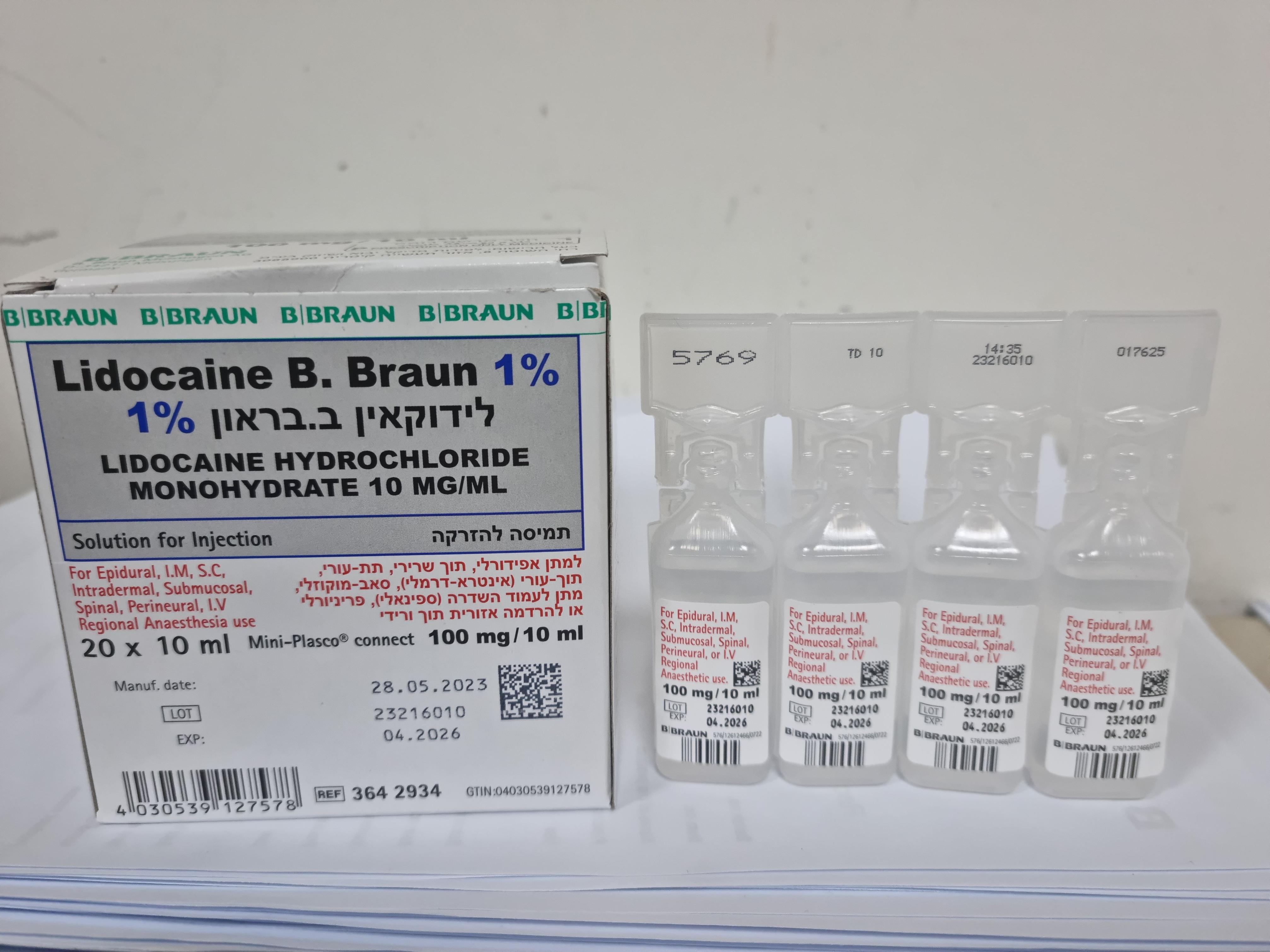Quest for the right Drug

לידוקאין ב.בראון % 1 LIDOCAINE B.BRAUN 1 % (LIDOCAINE HYDROCHLORIDE MONOHYDRATE)
תרופה במרשם
תרופה בסל
נרקוטיקה
ציטוטוקסיקה
צורת מתן:
תוך-שרירי, אפידורל, תת-עורי, תוך-עורי, הזרקה תת-רירית, שדרתי, לסביבת העצב, : I.M, EPIDURAL, S.C, INTRADERMAL, SUBMUCOSAL, SPINAL, PERINEURAL, I.V REGIONAL ANAESTHESIA
צורת מינון:
תמיסה להזרקה : SOLUTION FOR INJECTION
עלון לרופא
מינוניםPosology התוויות
Indications תופעות לוואי
Adverse reactions התוויות נגד
Contraindications אינטראקציות
Interactions מינון יתר
Overdose הריון/הנקה
Pregnancy & Lactation אוכלוסיות מיוחדות
Special populations תכונות פרמקולוגיות
Pharmacological properties מידע רוקחי
Pharmaceutical particulars אזהרת שימוש
Special Warning עלון לרופא
Physicians Leaflet
Posology : מינונים
4.2 Posology and method of administration Posology Local and regional anaesthesia As a matter of principle the smallest possible dose that produces adequate anesthesia should be administered. The dosage should be adjusted individually according to the particulars of each case. Adults: When injected into tissues with marked systemic absorption, without combination with a vasoconstrictor, a single dose of lidocaine Hydrochloride monohydrate should not exceed 4.5 mg/kg body weight (BW) (or 300 mg). If combined with a vasoconstrictor, 7 mg/kg BW (or 500 mg) of lidocaine Hydrochloride monohydrate per single dose should not be exceeded. For the clinical uses listed below, recommendations for single doses and strengths of the injection solution to be administered to adults with average body weight (70 kg) are as follows: Type of anaesthesia Usual volume [ml] Concentration [%] Maximum dose [mg] Infiltration 0.5-1 300 500 (with epinephrine) Major nerve blocks 1-2 30-50 500 (with epinephrine) Minor nerve blocks 1 5-20 200 Epidural 1-2 15-30* 500 (with epinephrine) Spinal 1.5 or 5 in 7.5% glucose 1-2 100 Intravenous regional anaesthesia (IVRA) - upper limb 0.5 40 - lower limb 0.25 50-100 *1.5 ml per segment in average For prolongation of anaesthesia lidocaine may be combined with a vasoconstrictor, e.g. epinephrine. Addition of epinephrine at a concentration of 1:100 000 to 1:200 000 has proven useful. Paediatric population For children, the doses are calculated individually according to the patients’ age body weight and the nature of the procedure. Up to 5 mg/kg BW may be administered. With the addition of epinephrine, up to 7 mg/kg can be used. In children with a high body weight a gradual reduction of the dosage is often necessary and should be based on the ideal body weight. Standard textbooks should be consulted for factors affecting specific block techniques and for individual patient requirements. For anaesthesia in children, only a low strength (0.5 % w/v) of the local anaesthetic should be used. To achieve a complete motor block, a higher strength (1 % w/v) may be required. Lidocaine should be used with caution in children younger than two years of age as there are limited data to support the safety and efficacy of this product in this patient population at this time. Elderly patients For elderly patients, the doses must be calculated individually according to the patients’ age and body weight. Dosages may need adaptation as cardiac output and hepatic blood flow may decrease with advanced age indicating a decreased clearance of lidocaine (see section 5.2). Other special patient groups Doses should be reduced in patients in poor general condition or in those with reduced protein binding capacity (resulting e.g. from renal insufficiency, liver insufficiency, cancer, pregnancy). In patients with severe renal insufficiency the dose may need to be adapted due to reduced clearance and increased half-life of lidocaine (see section 5.2). Patients with liver diseases show reduced tolerance towards amide-type local anaesthetics. This may be due to reduced hepatic metabolism and decreased protein synthesis resulting in a lower protein binding rate of the local anaesthetic. Dose reduction is advisable in such cases. The dose should be reduced in patients showing clinical signs of cardiac insufficiency. Nevertheless, local or regional nerve blockage can be the anaesthetic method of choice in such patients. During pregnancy, the dose may need to be reduced depending on the type of anaesthesia. Regional anaesthetic blocks in which usually large doses are required should be avoided during the first trimester. For use in anaesthetic blocks in which smaller doses are administered the dosage may need to be reduced because of the altered anatomical and physiological characteristics in late pregnancy. Method of administration Local and regional anaesthesia Intradermal,intramuscular subcutaneous, or submucosal use (infiltration) perineural (injection into the surroundings of peripheral nerves), epidural or spinal use. Intravenous use regarding intravenous regional anaesthesia (Bier`s block). Every local anaesthetic procedure should only be carried out by personnel adequately skilled in the respective anaesthetic technique.

שימוש לפי פנקס קופ''ח כללית 1994
לא צוין
תאריך הכללה מקורי בסל
לא צוין
הגבלות
לא צוין
מידע נוסף
